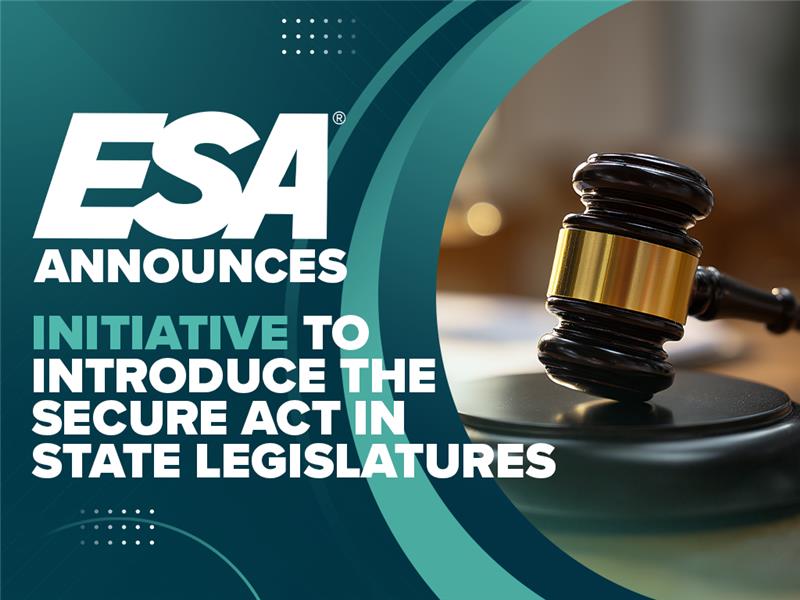What’s in the $2 Trillion Aid Package in Response to Coronavirus Crisis

The growing economic crisis for business and employees resulting from the government response to the coronavirus (COVID-19) pandemic is truly putting our economy on the brink of disaster. This includes the businesses and employees of many ESA members and all companies involved in the electronic security and life safety industry.
In response, a $2 trillion aid package will support businesses and employees who are suffering from the impact of this virus.
Let’s Peel Back the Layers and See What’s in This Bill…
It is important for those with an interest in specific provisions, rules, exceptions and limitations, read the actual bill text.
Title I – Keeping American Workers Paid and Employed Act
Section 1102. Paycheck Protection Program
- This section provides loans for small businesses with fewer than 500 employees
- It includes sole-proprietors, independent contractors and other self-employed individuals
- Maximum loan amount is $10 million that is tied to a formula based on payroll costs
- Provides delegated authority for lenders to make determination on eligibility without going through Small Business Administration (SBA) channels.
- Lowers the eligibility threshold during this crisis to require only that a business was operational on February 15, 2020 and had employees with paid salaries or paid independent contractors. It waives lender and borrower fees, credit test and collateral and personal guarantee requirements.
- It allows the Treasury Department to add additional lenders for the Paycheck Protection Program loans.
- Requires borrowers to make good faith certification that the loan is necessary, will be used to retain workers, maintain payroll, lease and utility payments and is not receiving duplicate funds from another SBA program for the same purpose.
- Allows for a complete deferment of loan payments for at least six months and not more than a year.
- $349 Billion appropriated for this program through the end of 2020.
Section 1106. Loan Forgiveness
- Borrowers will be eligible for loan forgiveness for two months from the beginning date of the loan for payroll costs, interest payments on any mortgage, rent payments and utilities. All mortgage, rent and utility payments must have originated before February 15, 2020.
- The amount forgiven will be reduced proportionately by any reduction in employees retained compared to the previous year. But, to encourage employers to re-hire people laid off, employers will not be penalized for having a reduced payroll at the beginning of the period, if they re-hire employees laid off due to the crisis.
- The portion of loans forgiven will not be considered taxable income.
- Amount not forgiven will have a maturity of not more than 10 years and the maximum interest rate will be four percent (4%).
Section 1109. United States Treasury Program Management Authority
- This section allows the Treasury Department, Farm Credit Administration and other federal regulatory agencies to authorize bank and non-bank lenders to participate, including insured credit unions in loans made under the Paycheck Protection Program.
Section 1110. Emergency EIDL Grants
- This section expands Economic Injury Disaster Loans to include businesses under 500 employees, sole proprietorships and independent contractors.
- It waives rules related to personal guarantee on advances and loans of not more than $200,000 during the covered period (January 31, 2020-December 31, 2020).
- It waives the rule that applicant needs to be in business for at least 1-year before the disaster but must have been in business at the beginning of the covered period.
- It allows an applicant to receive a $10,000 advance within 3 days of application. The advance does not need to be repaid, even if the EIDL loan is not approved. The advance must be used for providing paid sick leave to employees, maintaining payroll, making rent or mortgage payments or repaying other obligations that cannot be made due to revenue losses.
Section 1112. Subsidy for Certain Loan Payments
- For companies with existing SBA 7(a) loans, it requires the SBA to pay the principal, interest and any associated fees that are owed on the covered loan for a six-month period starting on the next payment date.
Title II – Assistance for American Workers, Families and Businesses
Section 2102. Pandemic Unemployment Assistance
- This section creates a temporary pandemic assistance program through the end of the year to provide payment for those not traditionally eligible for unemployment benefits (self-employed, independent contractors, those with limited work history and others) who are unable to work as a direct result of the coronavirus public health emergency.
Section 2014. Emergency Increase in Unemployment Compensation Benefits
- This section provides an additional $600 per week payment to each recipient of unemployment insurance or Pandemic Unemployment Assistance for up to four months.
Section 2105. Temporary Full Funding for the First Week of Unemployment
- This section provides funding to pay the cost of the first week of unemployment benefits for states that choose to opt in instead of the usual one week waiting period.
Section 2107. Pandemic Emergency Unemployment Compensation.
- This section provides and additional 13 weeks of unemployment benefits through the end of the year after regular unemployment benefits from states end.
Sections 2108-2111. Temporary Financing of Short-Time Compensation Payments in States with Programs in Law
- Section 2108 provides funding to support “short-time compensation” programs where employers reduce employee hours rather than laying off these workers and the workers receive pro-rated unemployment benefits.
- Sections 2019 through 2111 provide the funding mechanisms and grants to states totaling $100 million to implement “short-time compensation” programs.
Section 2201. Recovery Rebates for Individuals
- All U.S. residents with adjusted gross income up to $75,000 ($150,000 married) and have a valid Social Security Number are eligible to receive a $1,200 rebate ($2,400 married) rebate. They are eligible to receive an additional $500 per child. There is no minimum income requirement to receive this benefit. The rebate is reduced by income that exceeds the maximum by $5 per $100. The rebate is completely phased out for single filers at $99,000, $146,000 for head of households and $198,000 for joint filers with no children.
Section 2301. Employee Retention Credit
- This section provides a refundable payroll tax credit for 50 percent (50%) of wages paid by employers during the Coronavirus crisis if their operations were fully or partially suspended or gross receipts declined by more than 50 percent (50%) when compared to the same period last year.
Section 2302. Delay of Employer payroll taxes
- This section allows employers to defer paying payroll taxes during this period and make payments in two installments, one-half at the end of 2020 and the second half at the end of 2021.
Section 2303. Modifications for Net Operating Losses (NOL)
- This provision provides that a NOL arising from 2018-2020 tax years can be carried back five years. It also temporarily removes the taxable income limitation to allow a NOL to fully offset income.
Title III – Supporting America’s Health Care System
Subtitle C – Labor Provisions
Section 3601. Limitation on Paid Leave
- This section provides that an employer shall not be required to pay more than $200 per day and $10,000 in the aggregate for each employee under this section
Section 3602. Emergency Paid Sick Leave Limitation
- This section creates a limitation on sick leave to $511 per day and $5,110 total for sick leave or $200 per day and $2,000 total to care for a quarantined individual or child for each covered employee.
Section 3605. Paid Leave for Rehired Employees
- Allows employees laid off on March1, 2020 or later to have access to paid family and medical leave if they are rehired by the employer.
Title IV – Economic Stabilization and Assistance to Severely Distressed Sectors of the US Economy
Section 4002. Definitions
- Defines an “eligible business” as a U.S. business that has not otherwise received adequate economic relief in the form of loans or loan guarantees under this Act.
Section 4003. Emergency Relief and Taxpayer Protections
- $454 billion in support of eligible businesses, states and municipalities.
- All direct lending must meet certain criteria that includes:
- Alternative financing is not reasonably available;
- The loan is sufficiently secured or made at an interest rate that reflects the risk of the loan;
- The loan duration does not exceed 5 years;
- Borrowers and affiliates cannot engage in stock buybacks until the loan is no longer outstanding;
- Borrowers must maintain employment levels as of March 24, 2020 and maintain retain employees with certain criteria;
- The loan is not forgivable;
- All direct lending must meet certain criteria that includes:
Section 4004. Limitation on Certain Employee Compensation
This section prohibits officers or employees that exceed certain income thresholds from receiving severance packages or increases until the loan is paid.
Section 4022. Foreclosure Moratorium and Consumer Right to Request Forbearance
This section prohibits foreclosures on all federal-backed mortgage loans for a 60-day period beginning on March 18,2020. It also provides up to 180 days of forbearance for borrowers of a federally backed mortgage loan who have experience a financial hardship related to the COVID-19 crisis.
Section 4024. Temporary Moratorium on Eviction Filings
For 120 days from enactment of this Act, landlords are prohibited from initiating legal action to evict a tenant or charge fees, penalties or other charges where the landlord’s mortgage on that property is insured, guaranteed, protected or assisted in any way by HUD, Fannie Mae, Freddie Mac or the Violence Against Women’s Act.




